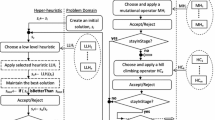Abstract
This work presents a local search approach to the High School Timetabling Problem. The addressed timetabling model is the one stated in the Third International Timetabling Competition (ITC 2011), which considered many instances from educational institutions around the world and attracted seventeen competitors. Our team, named GOAL (Group of Optimization and Algorithms), developed a solver built upon the Kingston High School Timetabling Engine. Several neighborhood structures were developed and used in a hybrid metaheuristic based on Simulated Annealing and Iterated Local Search. The developed algorithm was the winner of the competition and produced the best known solutions for almost all instances.









Similar content being viewed by others
Notes
http://www.utwente.nl/ctit/hstt/, accessed on 30th April, 2013.
http://www.idsia.ch/Files/ttcomp2002/, accessed on 30th April, 2013.
http://www.cs.qub.ac.uk/itc2007/, accessed on 30th April, 2013.
http://www.utwente.nl/ctit/hstt/itc2011/welcome/, accessed on 30th April, 2013.
http://sydney.edu.au/engineering/it/~jeff/hseval.cgi, accessed on April, 2013.
http://www.utwente.nl/ctit/hstt/archives/XHSTT-2012, accessed on April, 2013.
On instances AustraliaSAHS96 and AustraliaTES99, the initial solution generated by KHE was better than the provided solution, so KHE was used in these cases.
100 neighbors were considered in our tests.
Excluding the Brazilian instances, in which we could not compete.
We would like to highlight that for some of these instance there isn’t a known feasible solution yet.
References
de Haan, P., Landman, R., Post, G., & Ruizenaar, H. (2007). A case study for timetabling in a dutch secondary school. In: Lecture notes in computer science: VI practice and theory of automated timetabling (Vol. 3867, pp. 267–279). Berlin: Springer.
Even, S., Itai, A., & Shamir, A. (1976). On the complexity of timetable and multicommodity flow problems. SIAM Jounal of Computing, 5(4), 691–703.
Gendreau, M., & Potvin, J. (Eds.). (2010). Handbook of metaheuristics, international series in operations research and management science, (2nd ed., Vol. 146). Berlin: Springer.
Johnson, D.S., Aragon, C.R., McGeoch, L., & Schevon, C. (1991). Optimization by simulated annealing: An experimental evaluation Part II, graph coloring and number partitioning. Operations Research, 39(3):378–406, doi:10.1287/opre.39.3.378, http://pubsonline.informs.org/doi/abs/10.1287/opre.39.3.378
Kingston, J. (2013). Educational timetabling. In A. S. Uyar, E. Ozcan, & N. Urquhart (Eds.), Automated scheduling and planning, studies in computational intelligence (Vol. 505, pp. 91–108). Berlin: Springer. doi:10.1007/978-3-642-39304-4_4.
Kingston, J.H. (2005). A tiling algorithm for high school timetabling. In: Lecture notes in computer science: V Practice and theory of automated timetabling (Vol. 3616, pp. 208–225). Berlin: Springer.
Kingston, J. H. (2006). Hierarchical timetable construction. In Problems, proceedings of the first international conference on the practice and theory of automated timetabling.
Kingston, J. H. (2012). A software library for school timetabling. http://sydney.edu.au/engineering/it/~jeff/khe/, Retrieved April 2012.
Kirkpatrick, S., Gellat, D. C., & Vecchi, M. P. (1983). Otimization by simulated annealing. Science, 202, 671–680.
Kristiansen, S., & Stidsen, T. R. (2013). A comprehensive study of educational timetabling, a survey. Report 8.2013, DTU Management Engineering.
Lourenco, H. R., Martin, O. C., & Stutzle, T. (2003). Iterated local search. In F. Glover & G. Kochenberger (Eds.), Handbook of metaheuristics, chap 11. Boston: Kluwer Academic Publishers.
Lú, Z., & Hao, J. K. (2010). Adaptive Tabu Search for course timetabling. European Journal of Operational Research, 200(1), 235–244.
Muller, T. (2009). ITC2007 solver description: A hybrid approach. Annals of Operations Research, 172(1), 429–446.
Nurmi, K., & Kyngas, J. (2007). A framework for school timetabling problem. In Proceedings of the 3rd multidisciplinary international scheduling conference: theory and applications, Paris (pp. 386–393).
Pillay, N. (2013). A survey of school timetabling research. Annals of Operations Research. doi:10.1007/s10479-013-1321-8.
Post, G., Ahmadi, S., Daskalaki, S., Kingston, J. H., Kyngas, J., Nurmi, C., et al. (2010). An XML format for benchmarks in High School Timetabling. Annals of Operations Research, 3867, 267–279.
Post, G., Kingston, J. H., Ahmadi, S., Daskalaki, S., Gogos, C., Kyngas, J., Nurmi, C., Musliu, N., Pillay, N., Santos, H., & Schaerf, A. (2014). XHSTT: An XML archive for high school timetabling problems in different countries. Annals of Operations Research, 218(1), 295–301. doi:10.1007/s10479-011-1012-2.
Post, G., Gaspero, L., Kingston, J., McCollum, B., & Schaerf, A. (2013). The third international timetabling competition. Annals of Operations Research, 1–7. doi:10.1007/s10479-013-1340-5.
Santos, H. G., Ochi, L. S., & Souza, M. J. F. (2005). A tabu search heuristic with efficient diversification strategies for the class/teacher timetabling problem. ACM Journal of Experimental Algorithmics, 10, 2–9.
Santos, H. G., Uchoa, E., Ochi, L., & Maculan, N. (2012). Strong bounds with cut and column generation for class-teacher timetabling. Annals of Operations Research, 194, 399–412.
Schaerf, A. (1999). A survey of automated timetabling. Artificial Intelligence Review, 13(2), 87–127.
Souza, M., Ochi, L., & Maculan, N. (2003). A GRASP-Tabu Search Algorithm for solving School Timetabling Problems. Dordrecht: Kluwer Academic Publishers.
Valourix, C., & Housos, E. (2003). Constraint programming approach for school timetabling. Computers & Operations Research, 30, 1555–1572.
Wright, M. (1996). School timetabling using heuristic search. Journal of Operational Research Society, 47, 347–357.
Acknowledgments
The authors acknowledge FAPEMIG (Grant APQ-04611-10) and CNPq (Grant 552289/2011-6) for supporting the development of this research.
Author information
Authors and Affiliations
Corresponding author
Rights and permissions
About this article
Cite this article
da Fonseca, G.H.G., Santos, H.G., Toffolo, T.Â.M. et al. GOAL solver: a hybrid local search based solver for high school timetabling. Ann Oper Res 239, 77–97 (2016). https://doi.org/10.1007/s10479-014-1685-4
Published:
Issue Date:
DOI: https://doi.org/10.1007/s10479-014-1685-4




